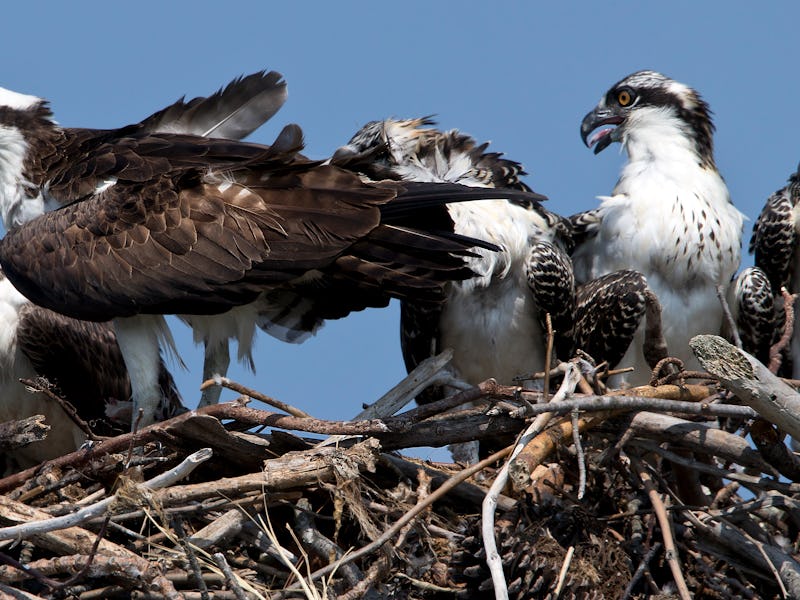Osprey Eggs Reveal Hopeful News About Long-Lived Environmental Contaminants
There's still a long way to go, though.

In the middle of the 20th century, birds in the United States faced dire population declines as a result of persistent pesticides and environmental contaminants, but new evidence suggests their situation may be improving. As long-lived substances like the pesticide DDT, the industrial chemicals called polychlorinated biphenyls — PCBs — and flame retardant chemicals called polybrominated diphenyl ethers — PBDEs — made their way up the food chain, they caused serious health and reproductive problems in the wild animals that consumed them.
This phenomenon, which Rachel Carson famously detailed in her 1962 book Silent Spring, led to the precipitous decline and near-extinction of the American bald eagle as DDT thinned eggshells and hurt the viability of embryos. At the same time, DDT and PCBs contributed to serious declines in fishery health all over the US, trends that continue to the modern day with fish consumption advisories in northeastern states. Decades after the federal government banned the use of the chemicals responsible, they still show up in wildlife, but new research suggests that the situation is gradually improving.
Researchers found that ospreys' eggshell thickness have returned to the levels observed back in the mid-20th century before widespread use of DDT caused rampant eggshell thinning.
In a paper that was published online on May 26 and will appear in the October 15 issue of the journal Science of the Total Environment, a team of researchers in Virginia and Maryland provide evidence that ospreys (Pandion haliaetus) in the Delaware Bay and Delaware River are slowly but surely showing signs of improvement from the environmental contamination of the 20th century. When the study’s authors sampled osprey nests in the region in 2015, they observed increasing numbers of viable young ospreys, lower levels of chemical contamination concentrations in eggshells, and eggshell thicknesses that had returned to pre-DDT levels.
Researchers observed these young ospreys in 2015 and found that their shells contained lower levels of environmental contaminants than in previous years.
“At one time environmental contamination had very significant effects on osprey reproduction and populations in Delaware Bay and some other estuaries,” Barnett Rattner, Ph.D., an ecotoxicologist at the US Geological Survey and first author on the new study, tells Inverse. Rattner and his colleagues had previously conducted a survey on ospreys in the region in 2002 and found that long-lived environmental contaminants were still impacting osprey health and fertility, even decades after they’d been taken out of circulation. But in the recent survey, Rattner and his team found that the situation was improving, and they assessed that osprey reproduction levels are now at a high enough level to be considered sustainable.
“Things are a little bit better than they were 12 years ago,” he says. “We were pleased to see as many osprey nests as we saw. There were definitely more in 2015 than we saw in 2002 in the places we studied.”
Since ospreys eat fish, they're susceptible to environmental chemicals that accumulate in the fish.
The researchers chose ospreys for this survey because they consider ospreys “sentinel” animals, meaning that, like the canary in the coal mine, their health is often an indicator of overall ecosystem health. Since DDT and PCBs biomagnify, which means their concentrations increase as they move up the food chain from bugs to fish to birds of prey, top-level predators like ospreys have been particularly vulnerable to these chemicals. So if ospreys are doing better, then it appears that the environment is likely doing better, too.
But this doesn’t mean that all is well. PCBs and DDT were phased out decades ago, and their damage still lingers in the environment — PBDEs were restricted more recently. So Rattner cautions that it will take a combination of patience and continued work to make sure that we don’t see osprey populations decline again.
“Because these chemicals have such a long half-life and are so stable in the environment, it’s going to take longer than it had been hoped for these chemicals to go away,” he says. “We have to be diligent and continue what has been done to reduce pollutant input into the estuary, and things will continue to get better. I think that’s a reasonable thing to say. Our paper didn’t really prove this. It’s just common sense.”